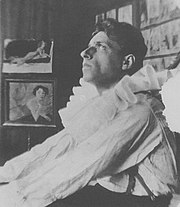Russian symbolism

Russian symbolism was an intellectual and
Literature
Influences
The Russian symbolism movement was primarily influenced by Russian thinkers such as
Rise of symbolism - The older generation
By the mid-1890s, Russian symbolism was still mainly a set of theories and had few notable practitioners. It was not until the new talent of Valery Bryusov emerged that symbolist poetry became a major movement in Russian literature. The early Russian symbolism movement included:
- Aleksandr Dobrolyubov
- Ivan Konevskoy
- Nikolai Minsky (whose most important contribution was his 1884 article "The Ancient Debate")
- Vladimir Solovyov (sometimes considered to be the primary Russian symbolist philosopher[1])
- Dmitry Merezhkovsky (the "father of Russian symbolism"[2])
- Valery Bryusov
- Alexei Remizov
Though the reputations of many of these writers had faded by the mid-20th century, the influence of the symbolist movement was nonetheless profound. This was especially true in the case of
Younger generation: Ivanov, Blok, Bely

Russian symbolism flourished in the first decade of the 20th century. Many new talents began to publish verse written in the symbolist vein. These writers were especially indebted to the philosopher
Maximilian Voloshin, known best for his poetry about the Russian revolution, opened a poetic salon at his villa in the Crimea. Jurgis Baltrušaitis, a close friend of Alexander Scriabin and whose poetry is characterized by mystical philosophy and mesmerizing sounds, was active in Lithuania.
Of the new generation, two young poets, Alexander Blok and Andrei Bely, became the most renowned of the entire Russian symbolist movement.
The city of
Decline of the movement
Russian symbolism had begun to lose its momentum in literature by the 1910s as many younger poets were drawn to the
Despite intense disapproval by the Soviet State, however, Symbolism continued to be an influence on
More recently, Robert Bird has been less critical than the Literary Gazette, "Nomenclature notwithstanding, Russian Symbolism owed far less to
Visual arts
Probably the most important Russian symbolist painter was Mikhail Vrubel, who achieved fame with a large mosaic-like canvas The Demon Seated (1890) and went mad while working on the dynamic and sinister The Demon Downcast (1902).
Other symbolist painters associated with the
Music and theatre

The foremost symbolist composer was
As to more traditional theatre,
Nikolai Evreinov was one of a number of writers who developed a symbolist theory of theatre. Evreinov insisted that everything around us is "theatre" and that nature is full of theatrical conventions, for example, desert flowers mimicking stones, mice feigning death in order to escape cats' claws, and the complicated dances of some birds. Theatre, for Evreinov, was a universal symbol of existence.
References
- ^ a b "Symbolism". Encyclopædia Britannica. Retrieved 2023-02-21.
- ^ a b Waegemans, E. (2016). History of Russian Literature Since Peter the Great 1700-2000 (Revised edition. ed.). Antwerp: Publisher Vrijdag.
- ^ Olga Ivinskaya (1978), A Captive of Time: My Years with Pasternak, page 231.
- ^ Viacheslav Ivanov (2003), Selected Essays, Northwestern University Press. Page xi.
- ^ The Plays of Anton Chekhov, trans. Paul Schmidt (1997)
Bibliography
- Friedman, Julia. Beyond Symbolism and Surrealism: Alexei Remizov's Synthetic Art, Northwestern University Press, 2010. ISBN 0-8101-2617-6(Trade Cloth)

